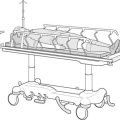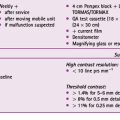Chapter 1 An introduction to ethics
 Ethics is a framework for the analysis and resolution of dilemmas and is loosely based on the concept of right and wrong.
Ethics is a framework for the analysis and resolution of dilemmas and is loosely based on the concept of right and wrong. A dilemma may have an ethical component if it has a moral agent, a subject, an action and a consequence.
A dilemma may have an ethical component if it has a moral agent, a subject, an action and a consequence. Radiographic practice involves a range of ethical considerations and decisions during the normal working day.
Radiographic practice involves a range of ethical considerations and decisions during the normal working day.WHAT IS ‘ETHICS’?
Ethics is defined as being ‘the study of the moral value of human conduct’,1 and whilst this definition is useful the study of ethics has evolved from purely a philosophical pursuit into a branch of philosophy which has enormous implications for healthcare practice in general. It may therefore be useful to examine the fundamentals of the study of ethics in an attempt to examine its applicability to practice.
As Box 1.1 would suggest, ethics is not to be thought of as the musings of philosophers that have no real life applicability, nor should it be regarded as simply a matter of applying common sense. Ethics provides us with a framework by which we can analyse dilemmas and hopefully this structured scrutiny will subsequently lead us to be able to resolve the dilemma we may face.
Box 1.1 The fundamentals of ethics2
WHAT IS AN ETHICAL DILEMMA?
Before we begin to examine the applicability of ethical analysis, it is essential that the exact nature of what essentially constitutes an ethical dilemma be understood, as opposed to being faced with choices that do not really have an ethical dimension to them. As previously stated, the study of ethics can be summarised as the analysis of what is right and/or what is wrong in any given situation and it also assists us with the concept of how we ought to act at any given time. We make a lot of choices during daily life and not all of these choices necessarily have an ethical element involved with them. What we decide to wear, for example, is not normally of great moral concern. While an individual might inadvertently offend people with their terrible dress sense it would not necessarily be doing anyone any great harm, so as a result would not really be worthy of any kind of ethical/moral scrutiny or debate. If, however, this was taken a stage further and a T-shirt with a racistslogan worn, this could truly offend many individuals as they quite rightly would regard individuals from another race as being worthy of their consideration. In other words individuals, or indeed communities, matter and we should consider their feelings, whereas choosing to wear black or purple is not really of any great concern to individuals or society in general. Box 1.2 demonstrates that for a dilemma to have an ethical dimension it should encompass the following elements: 1) a moral agent; 2) a subject; 3) an action and 4) a consequence.3 All these elements have to be present before the dilemma can be defined as having an ethical dimension afforded to it.
BASIS OF MORAL REASONING
This analysis of ethical problems can alternatively be termed ‘moral reasoning’. Here we can look at a problem and apply our moral and/or professional values to it. We can then decide what is the right option or course of action to take. We are all in possession of our own moral code (in other words, what we perceive as being right and wrong) and it is this code that we sometimes consult when deliberating about an issue. There has been much debate regarding our moral/ethical development;4 however, it would seem that our moral reasoning capabilities may be influenced by a complex mixture of internal and external factors.
All the elements mentioned in Box 1.3 serve to provide us with our own set of values. These values may change as we mature or gain ‘life experience’ but they may also be supplemented by additional rules or values that come when we adopt a professional role.
THE MAIN ETHICAL THEORIES
DEONTOLOGY
Immanuel Kant,5 who was a philosopher in the 18th century, first proposed this theory, based on the idea of rights and duties. He hypothesised that:
Applying this theory, it would be widely accepted that we have a duty of care towardsour patients and it would seem sensible that we should carry out that duty in a fair and just manner; i.e. treat all patients with equal regard. The main problem with this theory was how we could construct rules that could be applied universally; in other words, in every circumstance. So although we would like to treat all our patients equally it would seem very unfair to not give priority to those most in need. It would also not seem at all rational to ignore the consequences of our actions, even if they were well intended.
CONSEQUENTIALISM
Later on, in the 19th century, John Stuart Mill and Jeremy Bentham6 went on to develop a theory by which the value of any action was based solely upon the end result or consequence. They termed this theory ‘utilitarianism’ and argued that certain utilities should be maximised if an act was to be performed. Their main utility was happiness and they believed that the aim of all human endeavour should be to strive towards ‘The greatest happiness of the greatest number’. They believed that:
THE FOUR PRINCIPLES APPROACH
The two aforementioned theories are indeed just that – theories – and much of the criticism levelled against them was that they had flaws when applied to real-world dilemmas. It was with this in mind that Beauchamp and Childress7 attempted to develop a more user friendly and more easily applicable theory that we could apply in any given situation. They framed their arguments into what has been commonly termed ‘the four principles approach’, which is summarised in Box 1.4.
For example, if a patient came into your department asking to be treated only by a female radiographer, she would be exerting her autonomy in making that request. Normally this would not be an issue, but if on this occasion the section of the department was staffed purely by men, you would have a problem: by facilitating the request you would please the patient but delay her procedurewhilst you reallocated staff (causing possible harm) and you might also inconvenience the patients to whom the female radiographer was already attending. Also, would it be right and fair (justice) that one patient should be able to disrupt others just to exert her choice? The four principles approach does not really help us to decide whether there should be limits to the patient’s autonomy or whether the justice aspect of this course of action should be given more credibility in the decision-making process. It is, however, very widely referred to within healthcare literature and, if nothing else, does assist us to begin to frame the debate and produce alternatives on our journey to a resolution.
APPLYING ETHICS TO RADIOGRAPHIC PRACTICE
STATEMENTS FOR PROFESSIONAL CONDUCT
Radiography’s professional body, The College of Radiographers,9 has over the years produced and adapted what it terms as statements of professional conduct in an attempt to clarify our professional role. So not only are we in possession of our own values, by entering into the radiography profession we agree to act in accordance with these statements (Box 1.5).
Box 1.5 Statements for professional conduct (2004)9
Statement 3
Radiographers have a duty of care towards patients they accept for imaging/treatment procedures.
Statement 5
Radiographers must identify and acknowledge any limitations in their knowledge and competence.
Statement 6
Radiographers must maintain and strive to improve their professional knowledge and competence.
Statement 7
Radiographers must uphold and enhance the good standing and reputation of the profession.
These statements are indeed based on ethical principles and it is quite easy to see where principles such as beneficence and non-maleficence have informed these statements, given that most are written for the benefit and protection of the patient or member of staff. There is also a strong deontological ideology in that there are many references to ‘duty’, so this would imply that the patient has the right to a reasonable standard of care. All professional codes could be criticised as being a little vague but their role is to provide guidance ratherthan being inflexible rules.7 Further expansion of each statement can be found in the full document that the college has produced.9
HOW SHOULD WE START TO ANALYSE AN ETHICAL DILEMMA?
So, armed with the theories, principles and codes we can then attempt to apply them to the dilemmas with which we are presented and this analysis is best done in a systematic way. Indeed some authors have formulated very structured ways of analysing dilemmas, which are termed ‘decision making models’, and whilst many of these are useful in particular circumstances, one size does not fit all and many people have criticised them as being too restrictive. It would be nice to create a computer program that would allow us to type in all our variables and it would then compute the right course of action but, sadly, the complexity of many situations would render this program of limited value. Instead, it may be helpful to logically work our way through a dilemma in a systematic way, applying a mixture of principles and professional codes as shown in Box 1.6.
Making these decisions is not always straightforward and the decision may become ‘fluid’ as all parties become more informed, or indeed they may reach a point where there is just too much information and a solution may seem impossible. It may be that in some cases all parties may have to choosethe least bad option but as long as this choice is based on sound principles then it will be ethically sound.
1 Collins Essential English Dictionary, 2nd edn. Glasgow: Harpercollins. 2006. Ethics
2 Stirrat GM. How to approach ethical issues – a brief guide. The Obstetrician & Gynaecologist. 2003;5:167-170.
3 Beauchamp TL, Childress JF. Principles of biomedical ethics, 5th edn, New York: Oxford University Press; 2001:15.
4 Kohlberg L. The stages of ethical development: from childhood through old age. Glasgow: Harpercollins, 1991.
5 Kant I. The moral law: groundwork of the metaphysics of morals. Oxford: Routledge Classics, 2005.
6 Bentham J, Mill JS. Utilitarianism and other essays. Harmondsworth, UK: Penguin Books, 1987.
7 Beauchamp TL, Childress JF. Principles of biomedical ethics, 5th edn, New York: Oxford University Press; 2001:67.
8 Crisp R, Slote MA. Virtue ethics (Oxford readings in philosophy). Oxford: Oxford University Press, 1997.
9 College of Radiographers. Statements of professional conduct. London: CoR, 2001.
Beauchamp TL, Childress JF. Principles of biomedical ethics, 5th edn. New York: Oxford University Press, 2001.
Campbell A, Gillett G, Jones G. Medical ethics. Melbourne, Australia: Oxford University Press, 2005.
Parker M, Dickenson D. The Cambridge medical ethics workbook: case studies, commentaries and activities. Cambridge, UK: Cambridge University Press, 2001.
Savulescu J, Hendrick J, Hope T. Medical ethics and the law. Edinburgh: Churchill Livingston, 2003.
Wilson BG. Ethics and basic law for medical imaging professionals. Philadelphia: FA Davis, 1997.
Towsley D, Cunningham E. Biomedical ethics for radiographers. London: Mosby, 1994.







